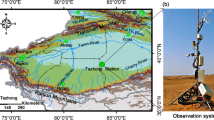Abstract
We have developed a parametrization of tidal effects for use in the Noah land-surface model and have validated the land-surface model using observations taken over a tidal flat of the western coast of South Korea. The parametrization is based on the energy budget of a water layer with varying thickness above the soil. During flood tide, heat transfer by the moving water is considered in addition to the surface energy budget. In addition, partial penetration of solar radiation through the water layer is considered in the surface energy budget, and the water thickness varying with time is used as an additional input. Seven days with clear-sky conditions and westerly winds during the daytime are selected for validation of the model. Two simulations are performed in an offline mode: a control simulation without the tidal effect (CONTROL) and a simulation with the tidal effect (TIDE). Comparisons of results have been made with eddy-covariance measurements and soil temperature data for the tidal flats. Observations show that inundation significantly reduces both sensible and latent heat fluxes during daytime, which is well simulated in the TIDE simulation. The diurnal variation and magnitude of soil temperature are better simulated in the TIDE than in the CONTROL simulation. Some underestimation of the latent heat flux over the water surface is partly attributed to the use of one layer of water and the underestimated roughness length at this site. In addition, other model deficiencies are discussed.








Similar content being viewed by others
References
Ahrens CD (2009) Meteorology today, 9th edn. Brook/Cole, Belmont, 527 pp
Andreas EL, Mahrt L, Vickers D (2012) A new drag relation for aerodynamically rough flow over the ocean. J Atmos Sci 69:2520–2537
Arya SP (2001) Introduction to micrometeorology. Academic Press, San Diego, 420 pp
Baldocchi DD, Falge E, Gu L, Olson R, Hollinger D, Running S, Anthoni P, Bernhofer Ch, Davis K, Fuentes J, Goldstein A, Katul G, Law B, Lee X, Malhi Y, Meyers T, Munger JW, Oechel W, Pilegaard K, Schmid HP, Valentini R, Verma S, Vesala T, Wilson K, Wofsy S (2001) FLUXNET: a new tool to study the temporal and spatial variability of ecosystem-scale carbon dioxide, water vapor and energy flux densities. Bull Am Meteorol Soc 82:2415–2435
Charnock H (1955) Wind stress on water surface. Q J R Meteorol Soc 81:639–640
Cuxart J, Conangla L, Jiménez MA (2015) Evaluation of the surface energy budget equation with experimental data and the ECMWF model in the Ebro Valley. J Geophys Res Atmos 120:1008–1022. doi:10.1002/2014JD022296
Dellwik E, Bingöl F, Mann J (2014) Flow distortion at a dense forest edge. Q J R Meteorol Soc 140:676–686
Garratt JR (1994) The atmospheric boundary layer. Cambridge University Press, New York, 316 pp
Henderson-Sellers B (1986) Calculating the surface energy balance for lake and reservoir modeling: a review. Rev Geophys 24(3):625–649
Harrison SJ (1985) Heat exchanges in muddy intertidal sediments: Chichester Harbour West Sussex, England. Estuar Coast Shelf Sci 20:477–490
Hong S, Dudhia J (2012) Next-generation numerical weather prediction. Bridging parameterization, explicit clouds, and large eddies. Bull Am Meteorol Soc 93: ES6–ES9. doi:10.1175/2011BAMS3224.1
Jarvis PG, McNaughton KG (1986) Stomatal control of transpiration: Scaling up from leaf to region. Adv Ecol Res 15:1–49
Kim TW, Cho YK, Dever EP (2007) An evaluation of the thermal properties and albedo of a macrotidal flat. J Geophys Res 112:C12009
Lee YH, Lee B, Kahng K, Kim SJ, Hong SO (2013) Quality control and characteristic of eddy covariance data in the region of Nakdong River. Atmos Korean Met Soc 23(3):307–320
Liu H, Zhang Q, Dowler G (2012) Environmental controls on the surface energy budget over a large southern inland water in the United States: An analysis of one-year eddy covariance flux data. J Hydrometeorol 13:1893–1910
Mahrt L, Ek M (1984) The influence of atmospheric stability on potential evaporation. J Clim Appl Meteorol 23:222–234
Mattias AD, Fimbres A, Sano EE, Post DF, Accioly L, Batchily AK, Ferreira LG (2000) Surface roughness effect on soil albedo. Soil Sci Soc Am J 64:1035–1041
Mitchell K (2005) The community Noah land-surface model (LSM). ftp://ftp.emc.ncep.noaa.gov/mmb/gcp/ldas/noahlsm/ver_2.7.1
Oleson K, Dai Y, Bonan G, Bosilovich M, Dickinson R, Dirmeyer P, Hoffman F, Houser P, Levis S, Niu GY, Thornton P, Vertenstein M, Yang ZL, Zeng X (2004) Technical description of the community land model (CLM). NCAR Technical Note NCAR/TN-461+STR, 173 pp
Payne RE (1972) Albedo of the sea surface. J Atmos Sci 29:959–970
Skamarock WC, Klemp JB, Dudhia J, Gill DO, Barker DM, Duda MG, Huang XY, Wang W, Powers JG (2008) A description of the advanced research WRF version 3. NCAR Technical Note, NCAAR/TN-475+STR, 113 pp
Slater RO, McIlroy IC (1961) Practical micrometeorology. CSIRO Division of Meteorological Physics, Melbourne 310 pp
Webb EK, Pearman GI, Leuning R (1980) Correction of flux measurements for density effects due to heat and water vapor transfer. Q J R Meteorol Soc 106:85–100
Wilson K, Goldstein A, Falge E, Aubinet M, Baldocchi D, Berbigier P, Bernhofer C, Ceulemans R, Dolman H, Field C, Grelle A, Ibrom A, Law BE, Kowalski A, Mayers T, Moncrieff J, Monson R, Oechel W, Tenhunen J, Valentini R, Verma S (2002) Energy balance closure at FLUXNET sites. Agric For Meteorol 113:223–243
Yang B, Raupach MR, Shaw RH, Paw UKT, Morse AP (2006) Large-eddy simulation of turbulent flow across a forest edge: Part I: flow statistics. Boundary-Layer Meteorol 120:377–412
Acknowledgments
This work was supported by the Integrated Weather Services for Urban and Rural Area of National Institute of Meteorological Research (NIMR).
Author information
Authors and Affiliations
Corresponding author
Rights and permissions
About this article
Cite this article
Lee, YH., Ahn, KD. & Lee, Y.H. Parametrization of the Tidal Effect for Use in the Noah Land-Surface Model: Development and Validation. Boundary-Layer Meteorol 161, 561–574 (2016). https://doi.org/10.1007/s10546-016-0178-1
Received:
Accepted:
Published:
Issue Date:
DOI: https://doi.org/10.1007/s10546-016-0178-1




